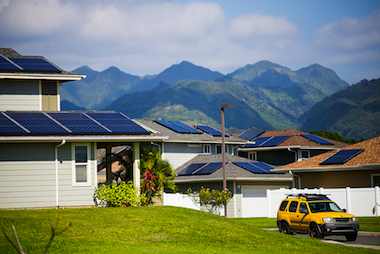The company says it has a plan to interconnect thousands of rooftop solar energy systems on Oahu by December 2015. But that has been put on hold because of safety and reliability issues.
“The utility will make it impossible to connect and the only option will be totally off-grid,” said Michael Angelo Leone, founder and owner of Off-Grid Hawaii in an email. “I have customers that just gave up and shut off their meters, soon to have the meters removed completely.
“[On Monday] I ran the numbers for one of my clients and with a loan over 10 years the cost of energy from off-grid solar was lower priced than power from the utility,” Kirk said. “No matter how you look at it, the Hawaii solar industry is still on fire — you just have to adapt to the conditions of the ever-changing market.”
“I think it’s about time [and] I hope it’s true,” said Aaron Kirk, the outgoing president of Hawaii-based Sunetric. “When hostages are released, we need to not ever thank their captors. I would just like to know, ‘what is different now?’
“What big technological upgrade magically fixed your grid and suddenly made these potentially dangerous [photovoltaic] installations safe to install?” Kirk said. ” How do I feel about this? I will be relieved when the solar industry is free and the people of Hawaii are free to choose an option to the monopoly.”
On Friday, HECO sent a letter to the Hawaii Public Utilities Commission in response to a request for information on the progress of interconnecting rooftop solar systems on Oahu, which totaled 4,807 as of late October.
Of the 4,807 customers currently “in the queue,” HECO said that it already is in the process of approving 2,058 customers, and of the remaining 2,749 customers, it will approve at least 2,500 of that amount by April.
The remaining systems will be approved by December 2015.
HECO noted that it’s using inverter technology to help interconnect more systems. It also is working on other solutions to tackle these interconnection challenges, including instituting such programs as energy storage and community solar in the first half of 2015.
But Kirk still isn’t impressed by the plan.
“Over the past two years I have watched HECO dismantle the solar industry in Hawaii, and they’ve done so with a marketing spin and a ‘we love clean energy’ sticker on their lapel,” he said in an email to PBN. “Solar is the only industry that I can think of whose biggest competitor has complete control over their business. It pains me to see the pace of solar installations reduced, when Hawaii residents have so clearly voiced their desire for a clean alternative to HECO’s services.”
Kirk, who had been with Sunetric for a little more than three years as director of sales, chief operating officer and then, most recently, president and chief operating officer, noted that the solar industry saved thousands of construction jobs during the Great Recession, and provides Hawaii residents with the only option to HECO’s expensive rates.
“Since September of 2013 I have seen several proposed ‘solutions’ by Hawaiian Electric, [including] grandfathering projects, keeping installations under 10 kilowatts, software changes within inverters, transfer switches, curtailment, and the list goes on,” he said. “The fact is that HECO’s ‘engineering problems’ that they claim could potentially make solar in Hawaii dangerous, do not exist and HECO’s method of measuring grid saturation using ‘minimum daytime load’ is so flawed that the saturation percentages may as well be randomly selected.”
The Hawaiian Electric Cos. have approved about 7,500 systems thus far this year, bringing the total number of rooftop solar projects approved for interconnection to a total of about 48,000 customers or about 11 percent of all customers, which is about 20 times greater than the national average of 0.5 percent at the end of 2013, according to the Solar Electric Power Association.
powkey Portable Power Station 350W, 260Wh/70,000mAh Backup Lithium Battery, 110V Pure Sine Wave Power Bank with 2 AC Outlets, Portable Generator for Outdoors Camping Travel Hunting Emergency
Now retrieving the rating.
$192.98 (as of April 26, 2024 14:01 GMT +01:00 - More infoProduct prices and availability are accurate as of the date/time indicated and are subject to change. Any price and availability information displayed on [relevant Amazon Site(s), as applicable] at the time of purchase will apply to the purchase of this product.)200W Portable Power Station, Powkey 120Wh/33,000mAh Power Bank with AC Outlet, 110V 6 Outputs Solar Generator External Battery Pack with LED Light for Home Use and Outdoor Camping
Now retrieving the rating.
31% OffFoldable Solar Panel Charger 60W with 18V DC Output (11 Connectors) for 100W~350W Portable Power Stations Jackery/Rockpals/Flashfish/Enginstar, Portable Solar Generator for Outdoor Camping Van RV Trip
Now retrieving the rating.
$98.99 (as of April 26, 2024 14:01 GMT +01:00 - More infoProduct prices and availability are accurate as of the date/time indicated and are subject to change. Any price and availability information displayed on [relevant Amazon Site(s), as applicable] at the time of purchase will apply to the purchase of this product.)10W USB LED Light for Camping Garage Warehouse Car Truck Fishing Boat Outdoor Portable Bulb, Emergency Light, Children Bed Lamp
Now retrieving the rating.
$9.99 (as of April 26, 2024 14:01 GMT +01:00 - More infoProduct prices and availability are accurate as of the date/time indicated and are subject to change. Any price and availability information displayed on [relevant Amazon Site(s), as applicable] at the time of purchase will apply to the purchase of this product.)EnginStar Portable Power Station 300W 296Wh Battery Bank with 110V Pure Sine Wave AC Outlet for Outdoors Camping Hunting and Emergency, 80000mAh Backup Battery Power Supply for CPAP
Now retrieving the rating.
15% Off





